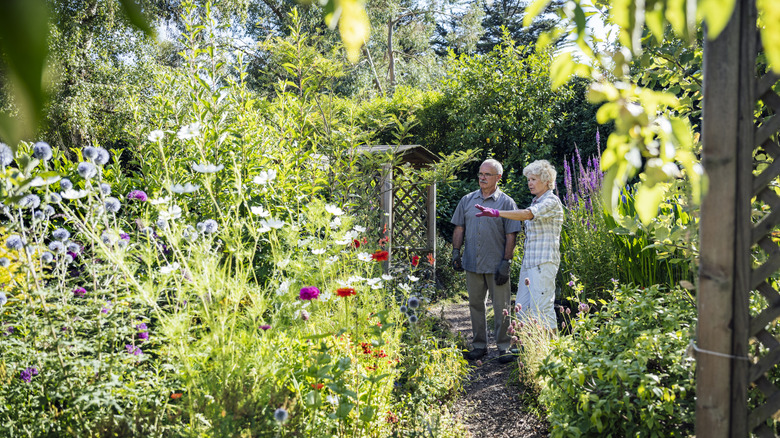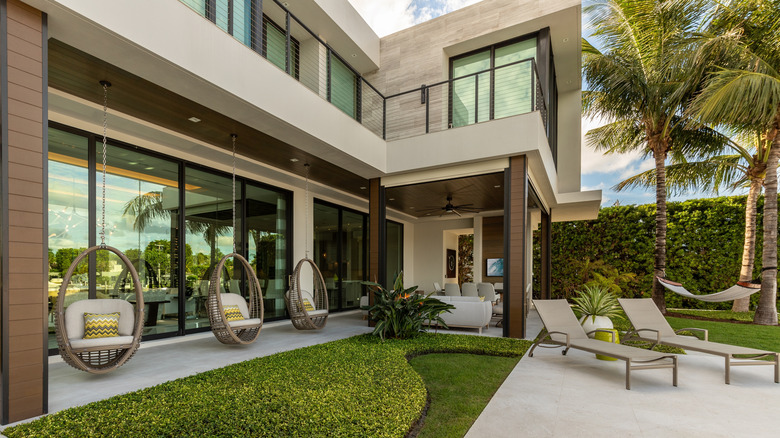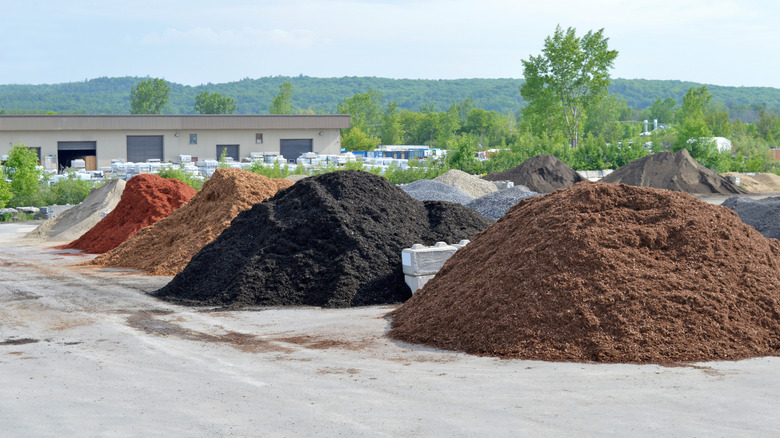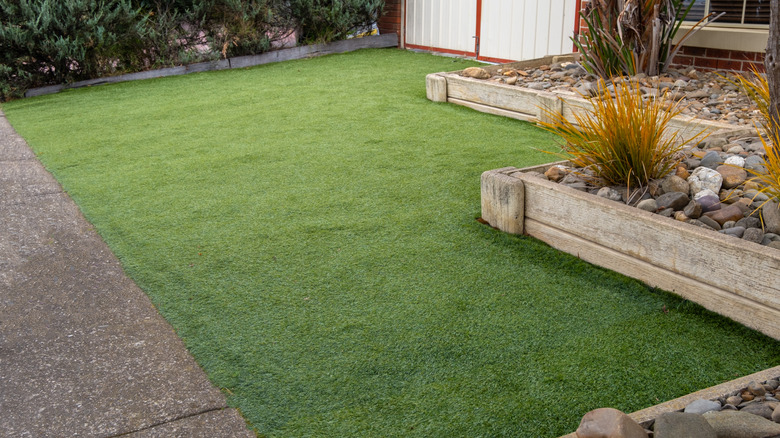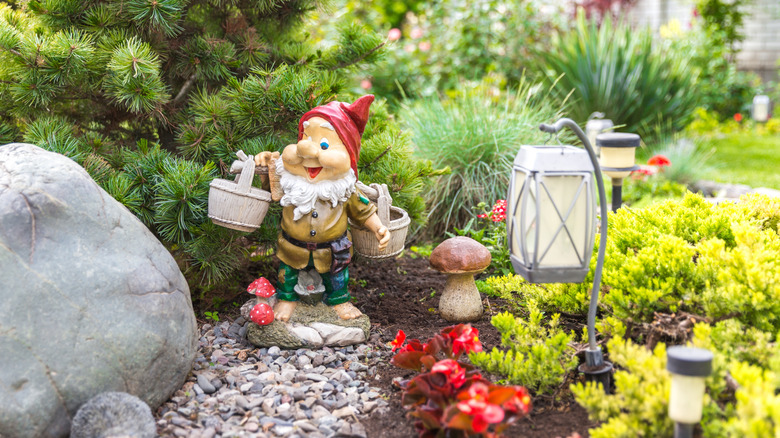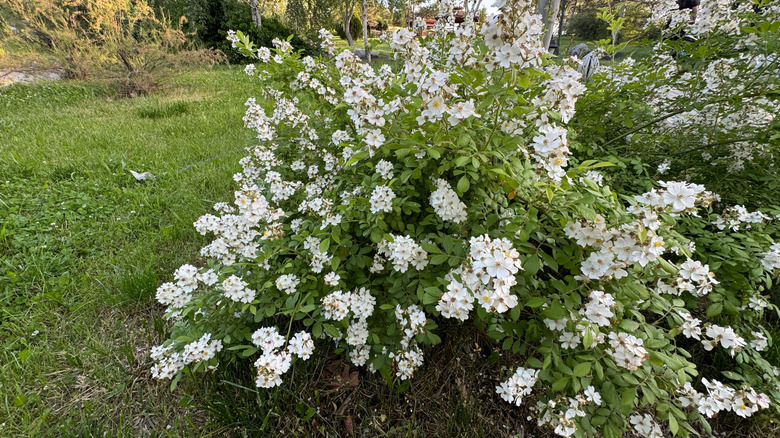Outdated Landscaping Trends To Leave In The Past (And What To Try Instead)
We may receive a commission on purchases made from links.
As the days get shorter and more of us are spending time indoors, it's fun to peruse garden catalogs and daydream about planting plans for next year. There are countless landscaping projects that can add charm to your yard, like incorporating a couple of mulched flower beds or growing grass that makes your lawn the talk of the neighborhood. Good landscaping creates a great first impression, and it can also make a big difference when it comes to your home's value. A survey by Trees estimates that unattractive and run-down yards can decrease property values by up to 30%. Whether you've got your eye on resale value, or simply want your yard to look fresh and current, here are some outdated landscaping trends to leave in the past (and what to try instead).
No matter which trends you decide to incorporate into your overall landscaping plan, before you get started it's important to consider site conditions like soil type and sun exposure. Along with determining your budget, you'll also want to research your planting zone to determine what's likely to grow best in your garden. Even the trendiest landscape designs can get stuck in the weeds, literally, if you don't dedicate enough resources to maintenance. If budget isn't an issue but you don't have much time to spare, consider xeriscaping or adding a large sculpture to your lawn. On the other hand, when there's nothing you would rather do than play in the dirt, maybe it's time to add more native plants to the mix.
Minimalist yards make way for cottage gardens, color, and boisterous blooms
Like many things minimalist, gardens featuring monochromatic color palettes, straight edges, and symmetrical plantings have enjoyed popularity for several years. But according to landscape architect Kevin Lenhart, that's all about to change. "We're seeing a big uptick for 'the maximalist yard,' " Lenhart said in an interview with Homes & Gardens, adding "The tides are turning after many years of neutral modernism to embrace lush plantings, flowers, and color in outdoor living spaces."
Maximalism is a major trend that shows no signs of stopping as we head into 2025. From the front row at fashion week to the front yards of homes across the country, the more-is-more design philosophy is underpinned by confidently combining colors and textures to create a boisterous effect. To put a maximalist spin on your garden, stagger plants of various heights (placing taller species at the back of borders), opt for close spacing, and select species that have bumper blooms for a profusion of color. Think sunflowers, dahlias, peonies, Mexican marigolds, zinnias, poppies, and the like.
You can play with scent, and height by training creepers with fragrant, eye-catching flowers like jasmine, native wisteria, or climbing roses up an arbor, arch, fence, or trellis. Instead of sleek, angular garden walkways, opt for romantically meandering paths, incorporate whimsical stepping stones or even build a tunnel trellis. Provide soothing sound with a water feature surrounded by ornamental grasses like Pink Muhly (Muhlenbergia capillaris), or, if you've got shade, exuberant clumps of hydrangeas. The key to nailing the maximalist landscaping trend is thinking lush and abundant, instead of neutral and contained.
Swap dyed mulch for natural options like cedar bark or pine straw
If you decide to embrace the maximalist trend, one way you shouldn't bring a riot of color into your landscape is by using dyed mulch. Although it may seem like a relatively simple way to add a pop of color or additional contrast in flower beds or around trees, dyed mulch is outdated and can contain toxic chemicals including arsenic. These contaminants come from the recycled wood the mulch is made from, can leach into your soil, and may cause harm to plants. Dyes can also run off during and after heavy periods of rain, and handling the mulch can be problematic, as it's apt to stain anything it touches.
What's more, there are many ways to use mulch in your yard and garden without jumping on this dated landscaping trend. You can use shredded bark, fresh woodchips, pine straw, hay, compost, or even shredded leaves to beautify your flower beds while enriching your soil and helping to conserve moisture. Cypress or cedar mulches are also great alternatives to colored mulch. Don't forget that your options aren't limited to organic materials. Stone and rubber mulches, while more costly, can also add long-lasting appeal to your landscaping.
Experts say artificial turf isn't safe for your family
The grass isn't always greener on the other side, especially if you use artificial turf. A low-maintenance alternative to natural grass, many homeowners in drought-prone areas embraced the synthetic product formerly confined mostly to football fields and sports arenas. Homeowners appreciated the water savings derived from this irrigation-free solution, despite it requiring regular cleaning, especially for pet parents who need to avoid stains or discoloration.
But like most products made from poly-fluoroalkyl substances (PFAS), also known as "forever chemicals", along with carcinogens and neurotoxins including lead, zinc, and black carbon, experts agree that artificial turf should officially be canceled. The Mount Sinai Children's Environmental Health Center recommends against the use of artificial turf, outlining that children are likely most vulnerable to the potential chemical exposure. Artificial turf also doesn't last forever. Warrantees on turf products typically range from 7 to 15 years. While it's installed, artificial turf contributes to soil compaction, higher levels of stormwater runoff, and microplastic pollution. A 2023 study published in Environmental Pollution revealed that up to 15% of micro- and mesoplastics present in rivers and oceans are from artificial turf. Once worn out, artificial turf eventually winds up in landfills.
Instead of installing artificial turf, you can grow a healthy lawn without harsh chemicals by selecting the right type of grass for the specific conditions in your yard, mowing frequently, and overseeding twice a year. If the ground is compacted, consider aerating your lawn, spread a thin layer of compost over it, and opt for natural fertilizers and hand weeding. Or, consider forgoing grass altogether by xeriscaping with drought-resistant plants.
One large focal point or functional piece is better than lots of decorative clutter
From fan swag to garden gnomes, personalized signs to pink flamingos, too much decorative clutter in your yard is on its way out. There's nothing wrong with hanging a cheerful Christmas wreath on your front door, or stringing café lights to create a cozy patio space for entertaining. But when you leave no spot or surface unclaimed in your garden, too many decorations can become an eyesore that makes your home less appealing to potential buyers. Of course, if your taste leans fun, quirky, and kitsch, and you're not looking to sell, then have at it with all the cute garden décor knick-knacks.
But if you do intend to list your home, or simply create a more mainstream garden and love yard art — skip the small plastic or acrylic tchotchkes and consider saving up for larger statement sculptures. You can also add visual and auditory interest with a feature like the bestselling Zen Stones and Lights Mirror Waterfall Fountain, which can look excellent on a covered porch or patio. If you're leaning into the maximalist look, or want to turn your backyard into a secret garden oasis, go for a more traditional option, like the Kenroy Home Ibiza Water Fountain. Gardeners can also consider using decorative trellises, retaining walls, or cloches to add interesting elements that are both functional and visually appealing.
Skip invasive plants at your local nursery in favor of native species that will thrive in your yard
Although your local nursery likely has many interesting and unique plants to choose from, according to a 2021 study by ecologists at the University of Massachusetts Amherst, many of the most popular ornamental garden plants for sale are non-native or invasive species. Worse yet, some of them are actually illegal to sell or grow. Non-native plants are ones that don't naturally exist in a given area without being introduced by humans who plant them. They aren't necessarily harmful to the surrounding native plants, while invasive species are both non-native and tend to disrupt ecosystems once they are introduced to a new area.
Popular ornamentals like Chinese wisteria (Wisteria sinensis), English ivy (Hedera helix), and Japanese honeysuckle (Lonicera japonica) are all plants that grow aggressively and displace the native species around them. To combat the spread of invasive plants, gardening trends are moving away from filling your cart with aggressive growers to carefully researching which plants are native to your area.
While they won't take over, native plants are likely to thrive without pampering because the surrounding conditions are ideal for their establishment and growth. They are also beneficial for the environment, supporting the existing wildlife as part of a symbiotic relationship with the surrounding area. For example, native plants are perfect for bringing birds to your yard.
